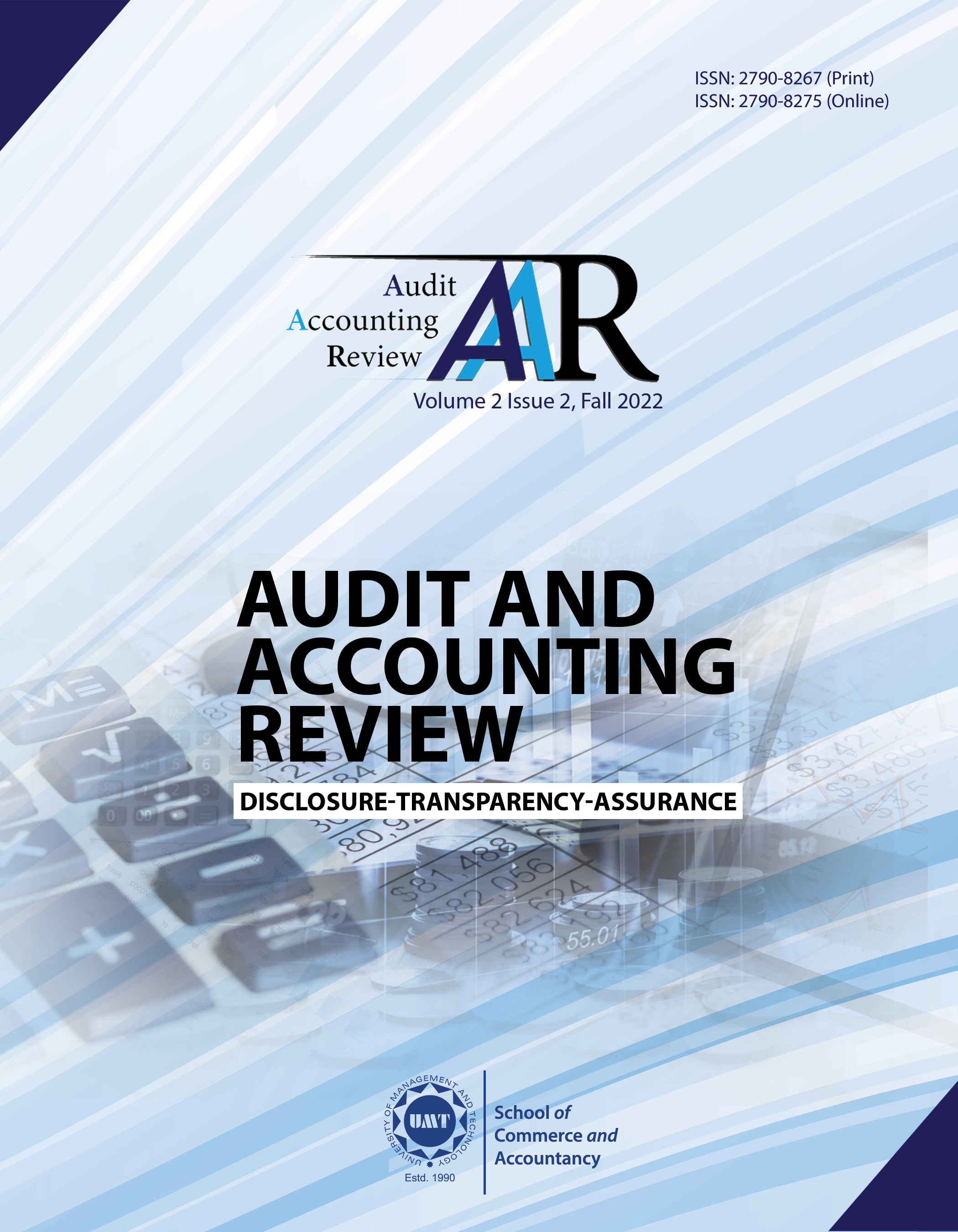Moderating Role of COVID-19 Crisis on Firm Leverage Speed of Adjustments: Evidence from Pakistan
Abstract
 Abstract Views: 66
Abstract Views: 66
This study evaluates the impact of firm-specific, industry-specific, and macroeconomic determinants on the speed of capital structure adjustment and to see if COVID-19 impacted these relationships. Using quarterly data of all listed non-financial firms in Pakistan for the period 2016-2021, a dynamic panel data model using the generalized method of moment (GMM) was used for estimation. It was found that firm size, growth potential, non-debt tax shield, and GDP growth positively impact firm leverage, while profitability and tangibility negatively impact leverage. The study found evidence of convergence to target leverage by Pakistani firms. These firms' capital structure adjustment speed was estimated as 16.7% per quarter. Moreover, COVID-19 was not found to affect the adjustment speed of firms, directly. Furthermore, greater distance from target leverage, growth potential, and GDP growth rate resulted in a lower speed of adjustment, whereas higher profitability and liquidity were found to increase the speed of adjustment.
Downloads
References
Abbas, Q., & Ahmad, A. R. (2012). Modeling Bankruptcy Prediction for Non-Financial Firms: The Case of Pakistan. SSRN Electronic Journal. https://doi.org/10.2139/ssrn.1917458
Abdeljawad, I., Rahim, R. A., Mat-Nor, F., Ibrahim, I., & Abdul-Rahim, R. (2013). Dynamic Capital Structure Trade-off Theory: Evidence from Malaysia. International Review of Business Research Papers, 9(6), 102–110.
Ahsan, H., & Mostafa Monzur, H. (2019). Corporate life cycle research in accounting, finance and corporate governance: A survey, and directions for future research. International Review of Financial Analysis, 61, 188–201. https://doi.org/10.1016/j.irfa.2018.12.004
Almilia, L. S., & Devi, d. 2007. FaktorFaktor yang Mempengaruhi Prediksi Peringkat Obligasi pada Perusahaan Manufaktur yang Terdaftar di Bursa Efek Jakarta. Proceeding Seminar Nasional Manajemen SMART. Bandung. 3 November. h:1-23.
Alnori, F., & Alqahtani, F. (2019). Capital structure and speed of adjustment in non-financial firms: Does sharia compliance matter? Evidence from Saudi Arabia. Emerging Markets Review, 39, 50–67. https://doi.org/10.1016/j.ememar.2019.03.008
Antoniou, A., Guney, Y., & Paudyal, K. (2008). The determinants of capital structure: Capital market-oriented versus bank-oriented institutions. Journal of Financial and Quantitative Analysis, 43(1), 59–92. https://doi.org/10.1017/s0022109000002751
Aybar-Arias, C., Casino-Martínez, A., & López-Gracia, J. (2012). On the adjustment speed of SMEs to their optimal capital structure. Small Business Economics, 39(4), 977–996. https://doi.org/10.1007/s11187-011-9327-6
Bajaj, Y., Kashiramka, S., & Singh, S. (2020). Application of capital structure theories: A systematic review. In Journal of Advances in Management Research, 18(2), 173–199. https://doi.org/10.1108/JAMR-01-2020-0017
Baker, M., & Wurgler, J. (2002). Market timing and capital structure. Journal of Finance, 57(1), 1–32. https://doi.org/10.1111/1540-6261.00414
Black, F. (1996). The dividend puzzle. Journal of Portfolio Management, SUPPL. https://doi.org/10.3905/jpm.1996.008
Bradley, M., Jarrell, G. A., & Kim, E. H. (1984a). On the existence of an Optimal Capital Structure: Theory and Evidence. The Journal of Finance, 39(3), 857–878. https://doi.org/10.1111/j.1540-6261.1984.tb03680.x
Burgess, S. M., & Dolado, J. J. (1989). Intertemporal rules with variable speed of adjustment: An application to UK manufacturing employment. The Economic Journal, 99(396), 347–365. https://doi.org/10.2307/2234029
Chakrabarti, A., & Chakrabarti, A. (2019). The capital structure puzzle – evidence from Indian energy sector. International Journal of Energy Sector Management, 13(1), 2–23. https://doi.org/10.1108/IJESM-03-2018-0001
Chua, M., Mohd, S. N. & Yahya, M. H. (2022). Family ownership and Speed of Adjustment (SOA) towards Optimum Capital Structure. Empirical Economics Letters, 21 (Special Issue 2), 40–52.
Dang, T. L., Dang, V. A., Moshirian, F., Nguyen, L., & Zhang, B. (2019). News media coverage and corporate leverage adjustments. Journal of Banking and Finance, 109, e105666. https://doi.org/10.1016/j.jbankfin.2019.105666
de Jong, A., Kabir, R., & Nguyen, T. T. (2008). Capital structure around the world: The roles of firm- and country-specific determinants. Journal of Banking and Finance, 32(9), 1954–1969. https://doi.org/10.1016/j.jbankfin.2007.12.034
Devi, A., & Devi, S. (2014). Determinants of firms’ profitability in Pakistan. Research Journal of Finance and Accounting, 19(5), 87–91. https://www.iiste.org/Journals/index.php/RJFA/article/view/16846
Doğan, M. (2013). Does firm size affect the firm profitability? Evidence from Turkey. Research Journal of Finance and Accounting, 4(4), 53–59. https://core.ac.uk/download/pdf/234629457.pdf
Donthu, N., & Gustafsson, A. (2020). Effects of COVID-19 on business and research. Journal of Business Research, 117, 284–289. https://doi.org/10.1016/j.jbusres.2020.06.008
Drobetz, W., Schilling, D. C., & Schröder, H. (2015). Heterogeneity in the speed of capital structure adjustment across countries and over the business cycle. European Financial Management, 21(5), 936–973. https://doi.org/10.1111/eufm.12048
Drobetz, W., & Wanzenried, G. (2006). What determines the speed of adjustment to the target capital structure? Applied Financial Economics, 16(13), 941–985. https://doi.org/10.1080/09603100500426358
Elsas, R., & Florysiak, D. (2011). Heterogeneity in the Speed of Adjustment toward Target Leverage. International Review of Finance, 11(2), 181–211. https://doi.org/10.1111/j.1468-2443.2011.01130.x
Fama, E. F., & French, K. R. (2002). Testing Trade-Off and pecking order predictions about dividends and debt. Review of Financial Studies, 15(1), 1–33. https://doi.org/10.1093/rfs/15.1.1
Fischer, E. O., Heinkel, R., & Zechner, J. (1989). Dynamic capital structure choice: Theory and tests. The Journal of Finance, 44(1), 19–40. https://doi.org/10.1111/j.1540-6261.1989.tb02402.x
Fitzgerald, J., & Ryan, J. (2019). The impact of firm characteristics on speed of adjustment to target leverage: A UK study. Applied Economics, 51(3), 315–327. https://doi.org/10.1080/00036846.2018.1495822
Flannery, M. J., & Rangan, K. P. (2006). Partial adjustment toward target capital structures. Journal of Financial Economics, 79(3), 469–506. https://doi.org/10.1016/j.jfineco.2005.03.004
Frank, M. Z., & Goyal, V. K. (2009). Capital structure decisions: Which factors are reliably important? Financial Management, 38(1), 1–37. https://doi.org/10.1111/j.1755-053X.2009.01026.x
Getzmann, A., Lang, S., & Spremann, K. (2014). Target capital structure and adjustment speed in asia. Asia-Pacific Journal of Financial Studies, 43(1), 1–30. https://doi.org/10.1111/ajfs.12038
Guney, Y., Li, L., & Fairchild, R. (2011). The relationship between product market competition and capital structure in Chinese listed firms. International Review of Financial Analysis, 20(1), 41–45. https://doi.org/10.1016/j.irfa.2010.10.003
Handoo, A., & Sharma, K. (2014). A study on determinants of capital structure in India. IIMB Management Review, 26(3), 170–182. https://doi.org/10.1016/j.iimb.2014.07.009
Hankins, K. W., Flannery, M. J., & Nimalendran, M. (2008). The effect of fiduciary standards on institutions’ preference for dividend-paying stocks. Financial Management, 37(4), 647–671. https://doi.org/10.1111/j.1755-053X.2008.00029.x
Heshmati, A. (2001). On the growth of micro and small firms: Evidence from Sweden. Small Business Economics, 17(3), 213–228. https://doi.org/10.1023/A:1011886128912
Hovakimian, A., Opler, T., & Titman, S. (2002). The capital structure choice: New evidence for a Dynamic Tradeoff Model. Journal of Applied Corporate Finance, 15(1), 24–30. https://doi.org/10.1111/j.1745-6622.2002.tb00338.x
Huang, G., & Song, F. M. (2006). The determinants of capital structure: Evidence from China. China Economic Review, 17(1), 14–36. https://doi.org/10.1016/j.chieco.2005.02.007
Ijaz, M. S., Hunjra, A. I., Hameed, Z., Maqbool, A., & Rauf-i-Azam. (2013). Assessing the financial failure using Z-score and current ratio: A case of sugar sector listed companies of Karachi stock exchange. World Applied Sciences Journal, 23(6), 863–870. https://doi.org/10.5829/idosi.wasj.2013.23.06.2243
Jun, S. G., & Jen, F. C. (2003). Trade-off model of debt maturity structure. Review of Quantitative Finance and Accounting, 20(1), 5–34. https://doi.org/10.1023/A:1022190205033
Khaki, A. R., & Akin, A. (2020). Factors affecting the capital structure: New evidence from GCC countries. Journal of International Studies, 13(1), 9–27. https://doi.org/10.14254/2071-8330.2020/13-1/1
Kim, H., Heshmati, A., & Aoun, D. (2006). Dynamics of capital structure: The case of Korean listed manufacturing companies. Asian Economic Journal, 20(3), 375–302. https://doi.org/10.1111/j.1467-8381.2006.00236.x
Köksal, B., & Orman, C. (2015). Determinants of capital structure: Evidence from a major developing economy. Small Business Economics, 44(2), 255–282. https://doi.org/10.1007/s11187-014-9597-x
Korajczyk, R. A., & Levy, A. (2003). Capital structure choice: Macroeconomic conditions and financial constraints. Journal of Financial Economics, 68(1), 75–109. https://doi.org/10.1016/S0304-405X(02)00249-0
Kraus, A., & Litzenberger, R. H. (1973). A state‐preference model of optimal financial leverage. The Journal of Finance, 28(4), 911–922. https://doi.org/10.1111/j.1540-6261.1973.tb01415.x
Lemma, T. T., & Negash, M. (2014). Determinants of the adjustment speed of capital structure: Evidence from developing economies. Journal of Applied Accounting Research, 15(1), 64–99. https://doi.org/10.1108/JAAR-03-2012-0023
Li, L., & Islam, S. Z. (2019). Firm and industry specific determinants of capital structure: Evidence from the Australian market. International Review of Economics and Finance, 59, 425–437. https://doi.org/10.1016/j.iref.2018.10.007
Lööf, H. (2004). Dynamic optimal capital structure and technical change. Structural Change and Economic Dynamics, 15(4), 449–468. https://doi.org/10.1016/j.strueco.2003.05.001
MacKay, P., & Phillips, G. M. (2005). How does industry affect firm financial structure? In Review of Financial Studies, 18(4), 1433–1466. https://doi.org/10.1093/rfs/hhi032
Memon, P. A., Rus, D. R. B. M., & Ghazali, D. Z. B. (2015). Dynamism of Capital Structure: Evidence from Pakistan. Journal of International Business and Economics, 3(1), 52–63. https://doi.org/10.15640/jibe.v3n1a7
Mitani, H. (2014). Capital structure and competitive position in product market. International Review of Economics and Finance, 29, 358–371. https://doi.org/10.1016/j.iref.2013.06.009
Miller, M. H., & Modigliani, F., (1963). Corporate income taxes and the cost of capital: A correction. American Economic Review, 53(3), 433–443. https://doi.org/10.2307/1809167
Mohammad, K. U. (2021). How bank capital structure decision-making change in recessions: Covid-19 evidence from Pakistan. Asian Journal of Economics and Banking, 6(2), 255–269. https://doi.org/10.1108/AJEB-04-2021-0049
Mohammad, K. U., & Khan, M. R. (2021). Bank capital structure dynamics and Covid-19: Evidence from South Asia. IRASD Journal of Economics, 3(3), 293–304. https://doi.org/10.52131/joe.2021.0302.0045
Myers, S. C. (1984). The Capital Structure Puzzle. The Journal of Finance, 39(3), 574–592. https://doi.org/10.1111/j.1540-6261.1984.tb03646.x
Nehrebecka, N., & Dzik-Walczak, A. (2018). The dynamic model of partial adjustment of the capital structure. Meta-analysis and a case of Polish enterprises. Zbornik Radova Ekonomskog Fakultet Au Rijeci, 36(1), 55–81. https://doi.org/10.18045/zbefri.2018.1.53
Nguyen, D. T., Diaz-Rainey, I., & Gregoriou, A. (2012). Financial Development and the Determinants of Capital Structure in Vietnam. SSRN Electronic Journal. https://doi.org/10.2139/ssrn.2014834
Öztekin, Ö., & Flannery, M. J. (2012). Institutional determinants of capital structure adjustment speeds. Journal of Financial Economics, 103(1), 88–112. https://doi.org/10.1016/j.jfineco.2011.08.014
Ripamonti, A. (2020). Financial institutions, asymmetric information and capital structure adjustments. Quarterly Review of Economics and Finance, 77, 75–83. https://doi.org/10.1016/j.qref.2020.01.010
Schmukler, S. L., & Vesperoni, E. (2006). Financial globalization and debt maturity in emerging economies. Journal of Development Economics, 79(1), 183–207. https://doi.org/10.1016/j.jdeveco.2004.12.006
Sulaiman, A. S., Mijinyawa, U. M., & Isa, K. T. (2019). Effects of financial performance, capital structure and firm size on firms’ value of listed consumer-goods firms in Nigeria. Dutse International Journal of Social and Economic Research, 2(1), 1–10. https://fud.edu.ng/journals/DIJSER/DIJSER_VOL2%20JULY2019/DIJSER_Vol2_No_1July_2019.pdf
Taylor, M. P., Peel, D. A., & Sarno, L. (2001). Nonlinear mean-reversion in real exchange rates: Toward a solution to the purchasing power parity puzzles. International Economic Review, 42(4), 1015–1042. https://doi.org/10.1111/1468-2354.00144
Thippayana, P. (2014). Determinants of capital structure in Thailand. Procedia: Social and Behavioral Sciences, 143, 1074-1077. https://doi.org/10.1016/j.sbspro.2014.07.558
Titman, S., & Wessels, R. (1988). The Determinants of Capital Structure Choice. The Journal of Finance, 43(1), 1–19. https://doi.org/10.1111/j.1540-6261.1988.tb02585.x
Trejo-Pech, C. O., Kyaw, N. N. A., & He, W. (2021). Capital structure adjustment behavior of listed firms on the Mexican stock exchange. Journal of Economics and Finance, 45(4), 573–595. https://doi.org/10.1007/s12197-021-09555-7
Yıldırım, D., & Çelik, A. K. (2021). Testing the pecking order theory of capital structure: Evidence from Turkey using panel quantile regression approach. Borsa Istanbul Review, 21(4), 317–331. https://doi.org/10.1016/J.BIR.2020.11.002
Copyright (c) 2022 Muhammad Mazhar Hussain, Khalil Ullah Mohammad

This work is licensed under a Creative Commons Attribution 4.0 International License.
Authors retain copyright and grant the journal right of first publication with the work simultaneously licensed under a Creative Commons Attribution (CC-BY) 4.0 License that allows others to share the work with an acknowledgement of the work’s authorship and initial publication in this journal.







